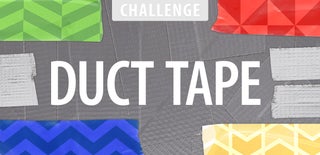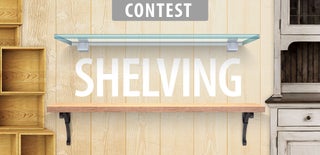Introduction: Tobacco Can and Duct Tape Shelf Supports
This Instructable will show how to make shelf supports from some used tobacco cans and duct tape. I will then go that extra step and mount the supports to some shelving to build functional shelves for my workbench.
This is a REMIX of two of my most recent Instructables.
PLUS
Find the Center of a Circle Without Measuring
While taking pictures of the Bench Bungs in their finished state it dawned on me that the tobacco cans may have another use when stacked together. Then while building the Desktop Pipe Shelving I realized I could use some shelving on one of my workbenches. Voila! The idea was born. Replace the pipe and flange supports with stacked tobacco cans.
Here we have a shelf Instructable REMIX where we are turning TRASH (empty tobacco cans) into a treasured shelf unit with minimal supplies including duct tape.
Step 1: Materials for Shelf Supports
Minimal supplies and tools are needed to make the shelf supports.
Tobacco Cans: I would guess that most if not all empty tobacco cans are destined for the landfill and a few of that many may actually make it to a recycle facility. Here is a great way to turn Trash into a practical Treasure.
Find a friend or friends who use this stuff and ask them to save their empty cans for you. Before you know it, you will have more cans than you know what to do with.
How many cans do YOU need? Well that depends on your plans of how tall you want your supports? In order to assist with your planning, I have included the dimensions of the cans. Not sure on other brands, but the Skoal cans measure as follow.
Can Dimensions
- Circumference: 8 1/2 inches. This will be good to know when cutting strips of duct tape to wrap and secure cans together.
- Diameter: 2 5/8 inches. Good to know when you are calculating surface area used on the shelf to mount your supports.
- Height: 7/8 inch. Valuable information when you are calculating the height of your supports when stacking cans. Don't make the mistake of rounding this to 1 inch as the difference will be apparent in your final product. I am using 11 cans per support. The rough height of each support is 9 5/8 inches. You would be 1 3/8 inch short if you thought you were going to get an 11 inch space between shelves.
Other Tools and Materials
- Scissors or utility knife for cutting tape cleanly.
- Duct Tape
- Measuring Tape
- Flat work surface.
- Hot Glue Gun and Glue Sticks
- Wood Screws
- Drill
- 1/8 inch drill bit.
Step 2: The Problem
Things are getting a little hectic on the work bench. Time to make some space and start moving vertical.
Step 3: Cost Savings
Taking into consideration that all of the cans were Trash or gifted, you pay nothing for the cans. I would estimate that you might use about 50 cents $1.00 worth of duct tape for this entire project.
Cost for a 4ft length of MDF will cost me about $4.
In contrast to my Desktop Pipe Shelving instructable, there is a huge cost savings over buying black pipe and flanges. To use black pipe flanges and nipples from a local DIY store, two supports would cost about $14! If you are going for aesthetics then maybe it is worth spending the money.
Amazon.com does not offer much of a savings, but you can find a huge savings on black pipe from this Ebay Seller.
Step 4: Connecting Cans
Once you have decided on how many cans you will be using per support it is time to stack and connect.
Start with a clean flat surface to work on. As I mentioned earlier the circumference of each can is 8.5 inches. I recommend cutting a strip of tape 8.5 inches long and laying it flat on your work surface adhesive side up. This will be easier to manage than trying to manage 3 cans and a roll of tape at the same time.
You can now connect connect 3 cans together with one strip of tape.
Step 5: Place Wrap and Roll
Let's start connecting these cans neatly and quickly.
- After stacking 3 cans align them centered over the tape strip. You will be taping the seams between the cans to connect them. The top of top can and bottom of bottom can will not be taped yet.
- Wrap one side of tape tight and neat.
- Roll your cans over the tape until completely wrapped.
- Give all the tape a good squeeze to adhere to cans.
Repeat the steps above for each group of three cans you will need for your project.
Step 6: Build and Connect Stacks
I will be using 11 cans total for each support as mentioned earlier.
I found working in groups of 3 is quite manageable. So after you create your groups of 3 you can start connecting the groups together in the same fashion as you did with single cans. Connect all 3 groups together until you have one stack of 9 cans. That will leave only two cans left to attach. Remember we are doing 11 cans total, but we need to put the end cans on a little differently.
Step 7: End Cans
Pay special attention to how you attach the end cans. We want be able to take the lids off the cans at each end. Why? It will come in handy when we mount the supports to the shelf. So, be sure to keep the lids facing out at the ends and do not tape these end cans shut yet.
Now we have one support done. Repeat previous steps to build another support. In all we will need 2 supports for this project. You might need more for your project.
Step 8: Mark Support Placement
Now we need to mark on our shelf boards where the supports will be placed and mounted.
For the purpose of my project, I have decided to use MDF 5/8" X 7 1/4" X 24" boards. I want to maximize the shelf space so I will be mounting my supports all the way to the edges of the shelves.
In the images I am marking the center point of the where the supports will be mounted. Since the cans are 2 5/8 inches in diameter
- Measure in from the edge of each board 1 5/16 inches. 1 5/16 is half of 2 5/8 right?
- Measure half the width of the board. Since the board is 7 1/4 inches wide I will go half of that at 3 5/8 inches.
- Drill 1/8 inch pilot holes for screw mount later.
- Dry fit things to test out the integrity of the supports and boards. It appears once supports are permanently mounted this will be a solid structure.
Step 9: Mark Can Lids
Next we will need to mark and mount the can lids to the shelving where we marked support placement. I found this down-and-dirty method to find the center of circle lids.
Step 10: Mount Lids to Shelves
After we find and mark the center of the circle lids..
Mounting Tools
- Drill
- 1/8 inch drill bit
- Hot glue gun and glue sticks.
- Wood screws.
- Screwdriver
- Just a little more Duct Tape.Mount the Lids
Mount the Lids
- Mark the center using the method linked above.
- Drill an 1/8 inch pilot hole.
- Glob on some hot glue.
- Screw it down.
Do this for each of the four lids.
Step 11: Assemble Shelves and Supports
Let's put this all together.
- Put a small amount of hot glue on the inside of the can lid mounted to the shelf.
- Insert support and hold firmly for about 30-60 seconds until glue cools.
- Wrap a final strip of tape around each support where lid attaches to support.
That should do it.
Step 12: Install
Now set your new shelf in it's desired new home. Stock it with whatever you wanted better organized and enjoy!
As mentioned earlier this is a Remix of two other of my most recent Instructables PLUS one more from a fellow Maker.
- Woodworker Bench Bungs
- GLOWING 5 Tier Desktop Pipe Shelving
- Find the Center of a Circle Without Measuring
My plan will be to build an identical unit to complement this one on my workbench. Need to salvage more tobacco cans.
Make It!
The WaerDog

Participated in the
Duct Tape Challenge 2017

Participated in the
Shelving Contest 2016

Participated in the
Trash to Treasure Contest 2017

Participated in the
Remix Contest 2016













